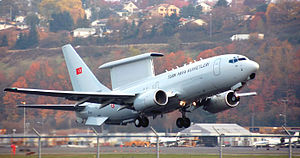Boeing 737 AEW&C
| Boeing 737 AEW&C E-7 Wedgetail |
|
|---|---|
 |
|
| Boeing 737 AEW&C built for the Turkish Air Force | |
| Role | Airborne early warning and control (AEW&C) |
| Manufacturer |
Boeing DSS (modifications) Boeing Commercial Airplanes (original 737 Next Generation design) |
| First flight | 2004 |
| Introduction | Early 2009 |
| Status | In use |
| Primary users |
Royal Australian Air Force Turkish Air Force Republic of Korea Air Force |
| Number built | 14 |
| Developed from | Boeing 737 Next Generation |
| Boeing Advanced Early Warning and Control interior compartments and systems | |
|
|
|
|
|
The Boeing 737 AEW&C is a twin-engine airborne early warning and control aircraft. It is lighter than the 707-based Boeing E-3 Sentry, and mounts a fixed, active electronically scanned array radar antenna instead of a rotating one. It was designed for the Royal Australian Air Force (RAAF) under "Project Wedgetail" and designated E-7A Wedgetail.
The 737 AEW&C has also been selected by the Turkish Air Force (under "Project Peace Eagle", Turkish: Barış Kartalı) and the Republic of Korea Air Force ("Project Peace Eye", Korean: "피스 아이"), and has been proposed to Italy and the United Arab Emirates.
In the 1990s, Australia began forming a need for an airborne early warning and control (AEW&C) aircraft. In 1996, Australia issued a request for proposal (RFP) for the aircraft for the RAAF under Project Wedgetail. In 2000, Australia awarded Boeing Integrated Defense Systems a contract to supply four AEW&C aircraft with options for three additional aircraft.
The 737 AEW&C is based on the Boeing 737 Next Generation design, roughly similar to the 737-700ER. The aircraft uses the Northrop Grumman Electronic Systems Multi-role Electronically Scanned Array (MESA) radar. The L-band (1 to 2 GHz) electronically scanned AEW and surveillance radar is located on a dorsal fin on top of the fuselage, dubbed the "top hat", and is designed for minimal aerodynamic effect. The radar is capable of simultaneous air and sea search, fighter control and area search, with a maximum range of over 600 km (look-up mode). When operating in look-down mode against fighter-sized target, the maximum range is in excess of 370 km. When used against maritime targets, the maximum range is over 240 km for frigate-sized targets. MESA is capable of simultaneously tracking 180 targets and conducting 24 intercepts. In addition, the radar antenna array is also doubled as an ELINT array, with a maximum range of over 850 km at 9,000 meter altitude. The 10.8 m long by 3.4 m high antenna assembly incorporates 7.3 m long by 2.7 m high Side-Emitting Electronic Manifold array, with the top hat supporting array providing 120° coverage on port and starboard side, while the top hat array itself provides 60° fore and aft, thus providing a complete 360° coverage. The radar's beam can be set for a 2° to 8° width, while scan duration can be set from 3 s to 40 s. Radar signal processing equipment and central computer are installed directly below the antenna array.
...
Wikipedia
